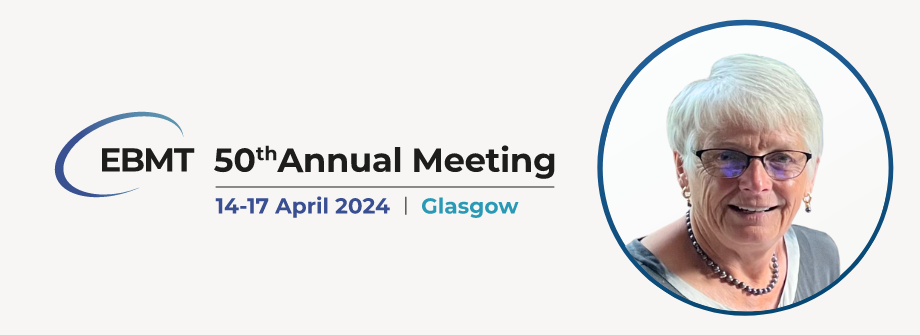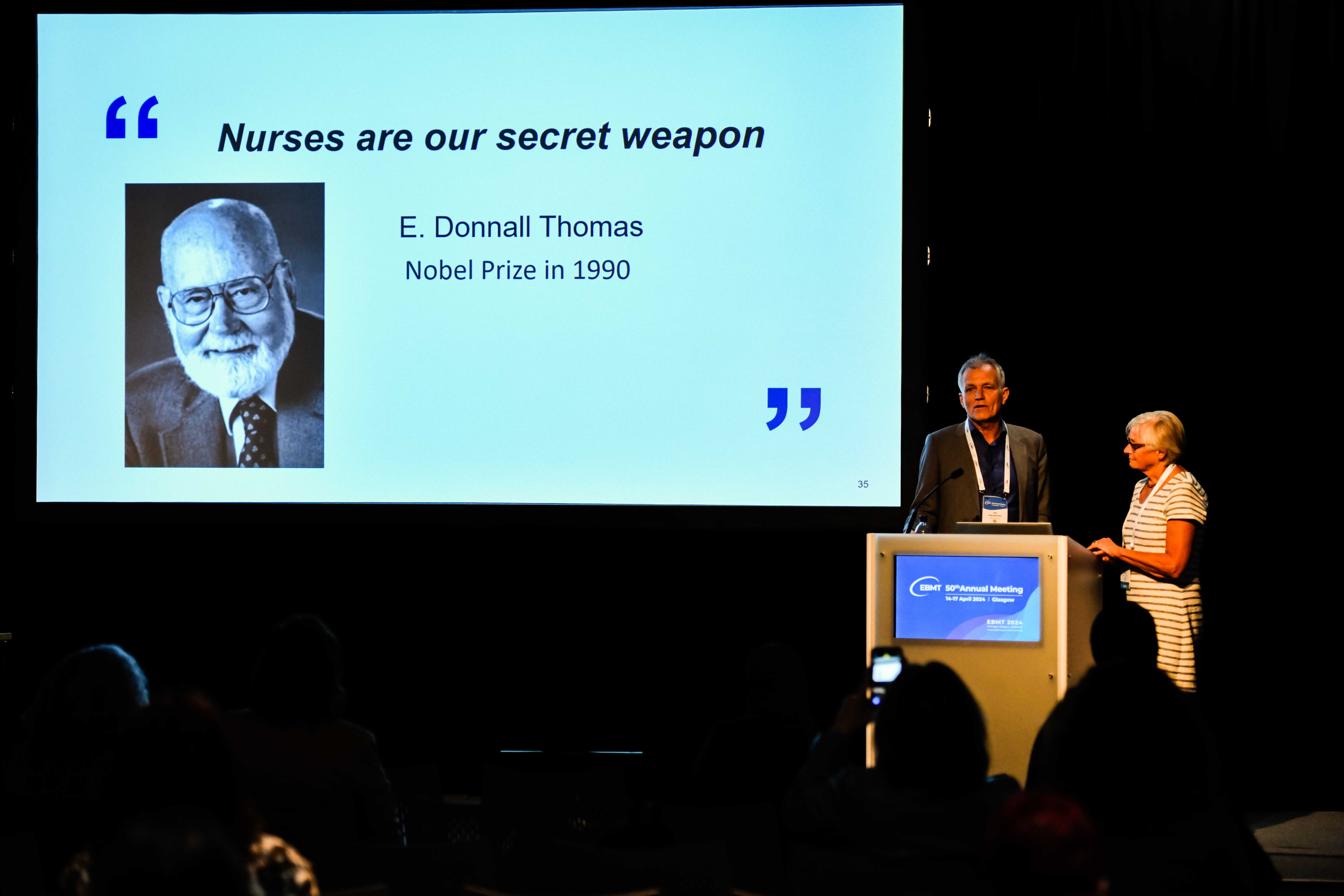
Carole Charley
Retired bone marrow transplant nurse; retired Quality Manager for BMT; and retired JACIE Accreditation Report Assessor; Past EBMT Nurses Group President
The EBMT Nurses Group brings together nurses and allied health professionals working within the field of haematology. How did this group start and how important is this collaboration?
We have to thank two very important Dutch nurses who had the foresight to suggest a European bone marrow transplant (BMT) organisation should be established. Celeste Dye and Yvonne Hagen were fortunate to attend the annual medical BMT in 1983. The medical group had been meeting since 1972, but did not formalise the group until 1985, when they introduced elections, etc. We all come away from these annual meetings filled with inspiration and ideas, but how often do we take them forward? Celeste and Yvonne wrote to BMT nurses, in Europe, suggesting an organisation should be formed to exchange ideas and knowledge, and their department in Leiden could be the centre for receiving and redistributing all ideas and information.
Nineteen months after the initial contact, Celeste and another colleague sent out invitations to BMT nurses to attend the first 1-day nurses meeting to be held in conjunction with the medical BMT meeting in January 1985, in Bad Hofgastein, Austria. Registration was free for the nurses who were invited to attend any of the medical presentations on the previous 2 days. You have to be aware the medical programme was arranged around skiing activities and networking. Therefore, the medical presentations were between 8–9.30 a.m., and again around 4–7 p.m. Medical staff would present their oral presentations wearing their skiing clothes for both sessions.
At this time, the BMT procedure was only performed in major centres; therefore, the aim of the European nurses organisation to exchange ideas and knowledge was very important.
Specifically considering your role as president of the Nurses Group, what achievement are you most proud of?
Having been invited to present at the second Nurses Group meeting in 1986, I was asked at the end of the meeting to help organise the third nurses meeting. Having said yes, I found myself in the role of president, which was not my intention. This was a daunting position to be in, as I had never organised a meeting in my life! My proudest achievement over the 4 years as president was to encourage, each year, non-English-speaking nurses to present at the annual meetings. This was, hopefully, achieved by encouraging a friendly atmosphere at each annual meeting, and giving nurses the confidence to ask questions in their own language, which were then translated into the presenter’s language, and then translated again so the participant asking the question could understand the answer. This allowed me to continue with the aims of sharing ideas and knowledge, which Celeste and Yvonne had suggested.
How important are the four Nurses Group Committees (Research, Scientific, Paediatric, and Global Educational Committee)?
The Nurses Group’s aims have widened over the past 4 decades; therefore, the original committee of four members needed to expand to allow the new aims of the group to be met.
Research has been on the Nurses Group’s agenda since 1988. As it was then, and today, research is very important, as nurses are required to provide evidence-based care for their patients and donors. The research committee not only performs research, but is there to give guidance on how to perform your research.
Paediatric care has been very important to the nurses group, and has been on the agenda since 1988. This has allowed paediatric nurses a platform to arrange their own programme for each annual meeting, and to share experiences, knowledge, and research.
With the expanding aims of the Nurses Group, it was apparent that a scientific committee was required to concentrate on producing an annual programme that fulfils the expectations of today’s BMT nurse.
As the original aim of the Nurses Group to provide knowledge and to share experiences with nurses across Europe has expanded to try and reach nurses across the world, especially those BMT nurses in low-income countries, the role of the Global Educational Committee has become extremely important.
Considering your career as a clinical nurse, later focusing on the field of BMT, how do groups and committees, such as the EBMT Nurses Group, help to shape the care you provided?
Having worked in the field of BMT since 1989, first as a clinical nurse and then in the role of Quality Manager, it has been very important, for me, to be involved in groups and committees such as the EBMT Nurses Group. Not only do you share ideas and knowledge, but you can also share your concerns of clinical practice and new therapies. These groups and committees not only provide knowledge that may change your clinical practice; they become a very important support system that you can contact at any time. Very often, members of the group or committee become special friends. This support, and the knowledge you are not alone, allows you to continue caring for your patient and/or donor to the best of your ability during difficult times. My involvement in such groups has allowed me to see the ‘bigger picture’, to improve the nursing care I gave to the patients and donors, share my knowledge by presenting oral and poster presentations at conferences, and share information when invited to visit BMT centres throughout the world. This helped to develop me as a clinical nurse, a quality manager, and as a person in my own right. I can surely say I would not be the nurse or character I am today if I had not been involved with the EBMT Nurse Group.
Again, considering your wider career, how have you seen the profession of nursing, and specifically nursing in the field of haematology, change since the start of your career?
When I became a student nurse, in 1971, there was only one intravenous antibiotic. When I started working in the field of BMT, in 1989, there were no antivirals, no specific treatment for graft-versus-host disease, and the donor was required not only to donate bone marrow, but also white cells every day until engraftment had occurred. The BMT procedure was experimental, and often performed as a last resort. Today, BMT is a recognised treatment for many diseases; therefore, today’s BMT nurse not only cares for the patient through ‘basic nursing care’, but also has to have an in-depth understanding of all the drugs used, an in-depth knowledge of possible complications of transplant, and ability to report signs and symptoms to medical staff. As in any medical speciality, the role of nursing has completely changed and has become so sophisticated. Yet, the BMT nurse has to remain caring and compassionate.
Do you feel that there are currently any unmet needs within your field and profession that require greater attention to improve patient outcomes?
As treatment becomes more targeted, hopefully, patient outcomes will continue to improve and fewer transplants will be required. If this is not the case, then special groups like the EBMT Nurses Group should be looking at ways to improve recruitment into the speciality. There is an ageing population, and the lack of interest in the younger population to become carers must be a concern for all those working in healthcare.
Which sessions are you most excited to attend at the 50th Annual Meeting of the EBMT?
Where do I start! What I like about the 2024 EBMT programme is the number of joint sessions between all disciplines. Therefore, for me, the joint session which includes the Nurse Group and the Patient Advocacy Committee representatives entitled ‘Co-creation in transplant and cell therapy - patients and nurse working together to build better care’ should be a very interesting session.
Having retired from clinical practice, I am also looking forward to the ‘The Next Generation’ session looking at early career challenges. These should be so different from the challenges I experienced.
Then we have the donor sessions, which, for me, are very important and as a retired Quality Manager and JACIE Report Assessor, the JACIE sessions will be very interesting.
We must not forget the informal networking opportunities away from the formal presentations, when you can fall into conversations with other participants during coffee, lunch breaks, and at the poster sessions. This is often the time when you can have an in-depth discussion that may change your practice.

Carole Charley & Ton van Boxtel
